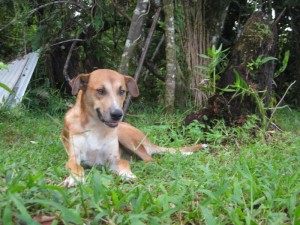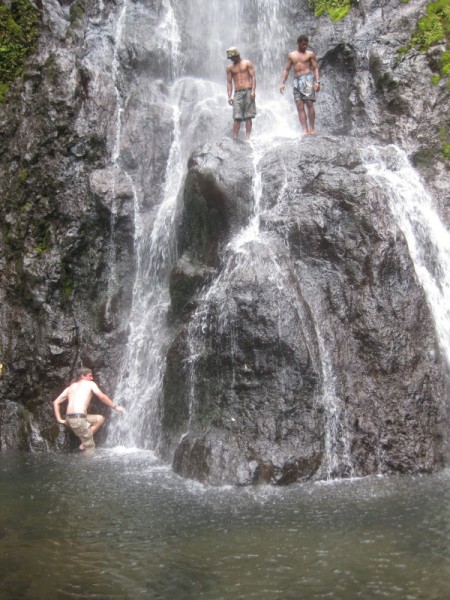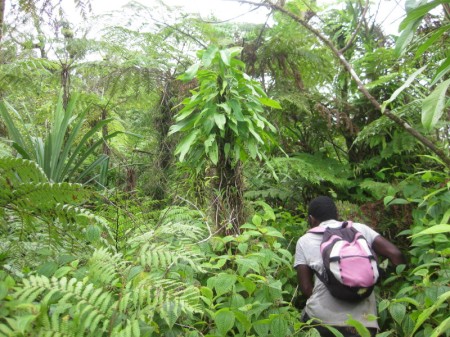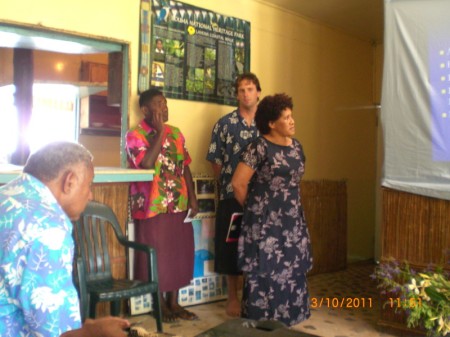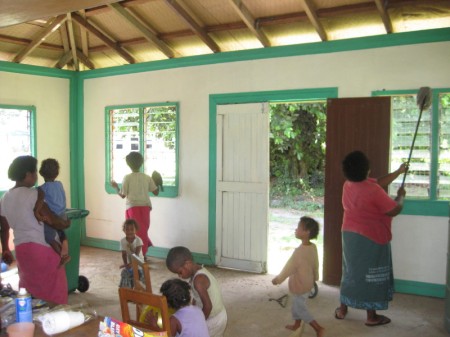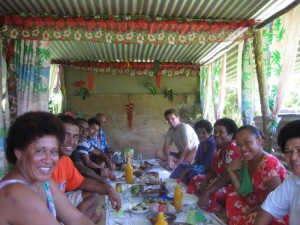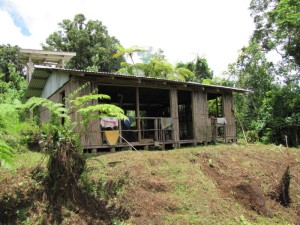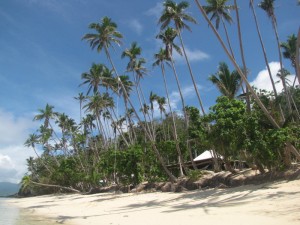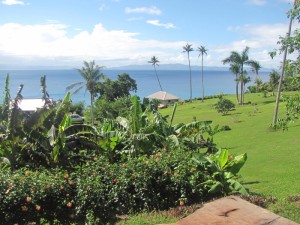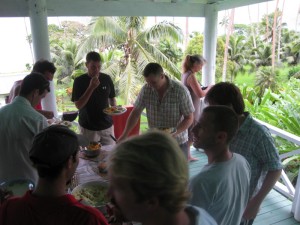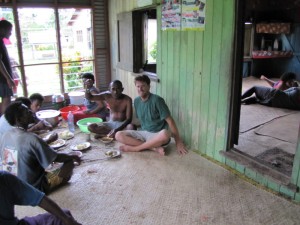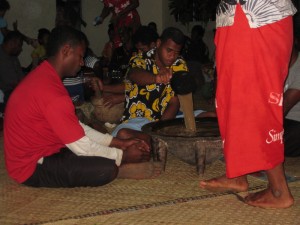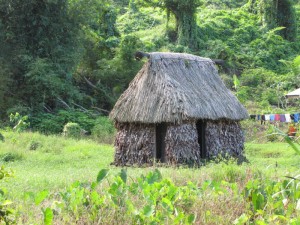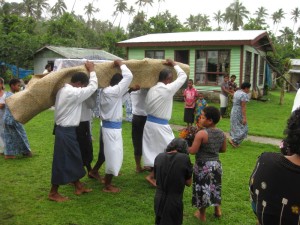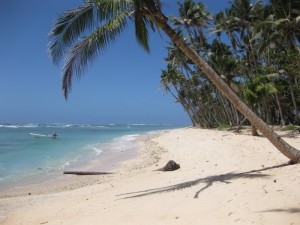
Lavena Beach
Bouma Day first came to my attention at the monthly manager’s meeting of Bouma National Heritage Park (BNHP). Bouma is the yasana (like a county) in which Vidawa and three other villages are located. BNHP is a project largely developed and funded by New Zealand Aid, a Non Government Organization (NGO); the goal of BNHP is to preserve the natural environment in a way that is beneficial to villagers providing income through tourism. Each village has a tourist attraction; Waitabu the village just north of Vidawa has a large Marine Protected Area and features snorkeling. Vidawa has the Rainforest Hike, Korovou, the village just south of Vidawa has the nearly famous Bouma Falls, and Lavena five kilometers south of Vidawa has the Lavena Coastal Walk and backpacker’s lodge. Attending the meeting are four village managers (one for each attraction), Sipi, who works for the National Trust, a government organization, and two Peace Corps Volunteers, Gloria (who lives in Lavena) and myself.
The meeting rotates villages monthly and this one was held at Lavena (my favorite location), on a picnic bench overlooking the ocean outside of the Lavena Lodge. It cost $30 a night Fijian to stay at the Lavena Lodge and while the accommodations are modest the location is second to none. If Lavena Village wasn’t at this location there is no doubt a 5 star resort would be. Fortunately, the village is there, and the modest Lavena Lodge provides an affordable place to stay on a perfect white sand beach (Return to the Blue Lagoon was filmed here) where tourists can get a taste of village life by observing and interacting with the residents.
The Fijians at the meeting have an annoying habit of speaking only in Fijian, leaving Gloria and I to pick up random bits of conversation and talk amongst ourselves. Gloria is a middle aged, disenchanted former HR Executive from New Hampshire, and it’s obvious to me that her long tenure in the corporate world and having become accustomed to a rigorous American work ethic make it hard for her to adjust to managing a business in Fiji, where sound business practices and making money are low on the list of priorities. She has been here a year longer than I. Occasionally the Fijians would break from their conversation and ask Gloria and I a question in English. Sipi, who works for the National Trust, brought it to our attention that the Bouma Primary and Secondary School (K-12) which serves almost all the children of Bouma had fallen far behind on the land lease and needed to raise about $4,000 Fijian. Bouma School is in Korovou village and leases land from the local mataqali (land controlling Fijian family) there. Bouma School has been at this location for about 20 years and has in fact never paid the land lease which is about $250 a year. The mataqali was calling in the marker for some reason.

Bouma School
To raise the money a traditional Fijian soli would be held, in which families from the area would all be accountable for a certain amount, I think it was $20 in this case, and there would be a party in which further funds would be raised. Sipi had the idea of inviting tourists from the resorts to ease the financial strain on the locals and wanted Gloria’s and my help putting together a flyer and organizing the event. Gloria politely balked, she stays very busy tending to the Lavena Lodge and was dismayed at what she perceived to be another fire emerging for laxness and irresponsibility. I, who am very lax and even irresponsible at times, didn’t hold this against them. I also have plenty of free time, not much has happened or appears to be happening with the previous projects I mentioned, so I volunteered to take on the task. The first step would be to meet with Pio, the manager of Tavoro Falls in Korovou (his village), and make a flyer.
I went to Pio’s house with my laptop and digital camera. At his house a group of Fijians were tinkering with a broken generator which, when working, provides a few hours of electricity to many of the houses in Korovou each night. Pio is a skinny man in his forties and is more reserved and quiet than most Fijians I’ve met. We went about setting up events which included Fijian vs. tourist sporting events, a meke (like a luau), music, yaqona drinking and more. It would be a full day of entertainment for a mere $20. It didn’t take long to draw up the flyer, and I took a picture of Bouma School to paste at the header. During the time we spent putting together the flyer Pio invited me to attend the Iguana Conference on Qamea Island with him and others the next day. I was quick to accept. I see Qamea daily, it’s right offshore from Vidawa, and I’d been wanting to go there. The island is home to several five star hotels, one upscale backpacker’s hostel, and about four villages.
The Iguana Conference would be regarding the influx of the “American Iguana” to Qamea and the surrounding islands. Of course, there is no “American Iguana,” and the posters plastered all over town in Taveuni are actually referring to the iguanas found in Central America and sometimes kept as pets. An ex-pat who had taken residence on Qamea had taken it upon himself to release several of the “American Iguanas” on the island and now they appear to be reproducing unchecked and are a serious threat of becoming a detrimental invasive species.
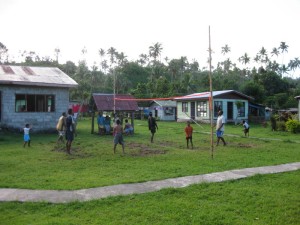
Vidawa Volleyball
Representing Vidawa at the conference would be myself and Tony, the manager of the Vidawa Rainforest Hike, and one of the few regular residents of Vidawa. Tony is the epitome of a carefree Fijian, having a relaxed nonchalant attitude toward most things, the demeanor of a man without a care in the world, at any given time having no more than a few dollars to his name but living well off his farm and the natural resources of the area.
We took a small open boat to Qamea and en route encountered a powerful rain squall. Tony removed himself from his position sitting on a rail at the stern of boat, got a tarp from a compartment, and stood in front of me holding the tarp in a way that looked uncomfortable for him. “What are you doing?” I asked.
“I’m shielding you from the rain,” he replied.
I laughed and said, “Uca, sega na lega. Daube mada” (Rain’s no problem, sit down.)
Arriving at Qamea I realized I had forgotten to bring my camera and cursed myself. Qamea was beautiful, just like Taveuni, only on a smaller, more condensed scale. The conference would be held at a village and I saw two other kaivalagi wondering around, our teachers for the day. One was middle aged and the manager of a large zoo in Australia. The other was younger, from London, and worked for an environmental NGO. They had caught two of the American Iguanas, which were of a decent size and, as we were told, pregnant females. The Fijians oooed and awed at the Iguanas which were docile and kept in make shift chicken wire cages.
During the Iguana Conference, which consisted of representatives from all over Fiji, including small remote islands, attention was brought to the potential dangers of the species: how they could reproduce unchecked, devastate local agriculture, and encroach on the native Fijian eco-system. It was recommended that all American Iguanas be killed if encountered. I looked at the captured Iguanas and suspected the end of the day would not find them well.
At the end of the conference came the grand finale, the eradication of the two captured iguanas, the manager of the zoo explained to me that drugs were taboo in the village so the iguanas would be decapitated rather than put to sleep. This may seem cruel but invasive species, the mongoose being the best example, have wreaked havoc on many of Fiji’s native species, driving some to extinction. Fijians are no strangers to killing their own food and aren’t ones to shy away from an execution. The entire village, old women, children, and the rest, gathered around a wooden chopping block on the beach to witness the event. A local Fijian did the deed with a cane knife (like a machete), and after two defined thunk sounds and gasps from the crowd, I knew the deed was done. I had shied away from the spectacle but suspect that the iguanas died quickly. Fijians learn to handle cane knives from the time they start walking and operate them with a high level of precision. Once the iguanas were decapitated the manager of the zoo cut the bellies open to show how many eggs a single female could carry. From each iguana’s abdomen emerged about thirty white balls in gelatinous goo.
The iguanas were dead and the conference was over, everyone had afternoon tea and pastries. Before leaving, the Taveuni crew did the only sensible thing, took a headless, eviscerated iguana, and a ball of gelatinous eggs, put them in a burlap sack and took them back to Taveuni to show others. Once back on Taveuni we took a taxi to our respective villages and along the way stopped at every village and even at every small settlement of houses. At each stop one of the Fijians would call the residents out and once a large audience was present pulled out the headless iguana. The villagers ooeed and awed at the bloody headless creature held before them. Then whoever happened to be presenting the specimen would put the headless iguana back in the bag and present the gooey eggs. The villagers were warned about the dangers the species presented and instructed to kill the American Iguana on site. This scenario played itself out at least ten times before I got dropped off at Vidawa and each time I watched an old Fijian lady jockey for position to get a better look at a headless iguana I cursed myself again for forgetting my camera.
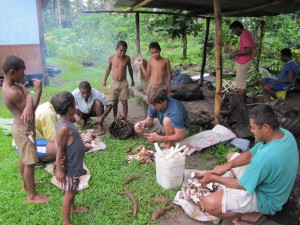
Lovo Preparation
Bouma Day had one problem I was concerned with, I would be gone for it. To further complicate matters, Gloria had ended her Peace Corps service early, citing health concerns. Bouma Day would fall on October 8th, at which time I would be on Viti Levu for EST (Early Service Training), a two week affair in which my entire group of volunteers would reconvene, discuss how things were going, and delve into our respective village projects in further depth. I had faith in my Fijian counterparts organizing the event but sometimes things get lost in translation or the cultural divide in what Fijians are used to vs. what guests might expect can cause a rift. Pio was my primary contact for the project so I left him a bullet pointed checklist of suggestions, the most important of which was to hand out the flyers I had made to the resorts a week before the event and then to call the resorts for an estimated guest count a few days prior. When I caught the flight to Viti Levu I felt confident I had done all I could.

Suva
I’d been looking forward to my trip to Suva, having not seen my peers or left Taveuni for three months. I’d also been looking forward to flying on the little plane I see coming and going from Matei airport, and the flight was not disappointing. The view from the air is very nice. The trip only takes an hour, and the little plane takes turbulence like a sports car with bald tires on a rain slicked road, giving flying a far more intimate feel than that provided by Boeing Jets. I can’t say the same for Suva and many of my experiences during EST, however.

waqa vuka lailai (little plane)
I had looked forward to Suva mainly because it was a developed city with all the comforts of home but quickly experienced what I guess could be considered reverse culture shock. Fijians in Suva hustle and bustle down crowded streets, their minds seem preoccupied, their heads down, and rarely, if ever, do you receive a friendly “Bula” or the carefree smile that I’ve become accustomed to in villages. Suva Fijians usually live in the city, have full-time jobs, rent or a mortgage, and live a lifestyle not unlike what many of us Americans are accustomed to. I always feel safe, even when walking alone on desolate roads in the Bouma Area but can’t say I felt the same when walking down dark alleys in Suva. Fiji Peace Corps Volunteers have been mugged before and it usually happened in the city. Another reminder of city life was Suva’s homeless population. Many elderly, crippled, or mentally disabled people were sleeping under store awnings, on benches, or clustered into groups in park areas. Homelessness is non-existent in the villages, where there may be fifteen people crowded into a small house at times, but to leave someone without a place to sleep is unacceptable by village standards. Although I enjoyed going to a few movies, Suva lost its appeal very quickly.
When my group reconvened we had lost a member and were down to 34, by the end of the first week of EST we were down to 33. I’ve kept in touch with most of the friends I have made. We are all on the same page and are enjoying our experience for the most part, even though some have experienced some health problems that would be embarrassing in the States. These problems include but are not limited to lice, scabies, ring worms, tape worms, and boils. While staying in a shared bure with many of those I don’t keep in regular contact with it became clear that not everyone was adjusting well to Fiji life. There were complaints of undefined goals, things not going according to plan, a lack of ambition among village counterparts, and the inability of Peace Corps staff to give definitive answers to conceptual questions and concerns. If there was one thing that was harped on more than anything else during training, it was things will likely not be going according to plan, so once you get to the village be ready to improvise. Furthermore, the ones who had the toughest sites and the ones who had experienced the worst health problems were not the ones complaining.
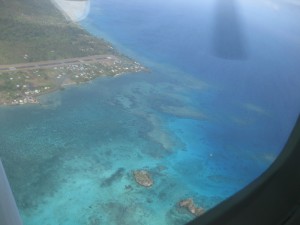
Matei (Northern Taveuni) from the air
Another eye-opener was a weekend trip most of us took to the Coral Coast on southern Viti Levu. The Coral Coast is the number one tourist destination in Fiji due to its close proximity to Nadi International Airport. The Coral Coast is developed, looks like a poorly designed suburb, boasts gated communities marketed to ex-pats from the world over, and bares little resemblance to the Fiji I have come to know. We stayed in a giant bure with about 40 beds at a large resort geared toward young people. The resort was owned by a young Australian who we had the displeasure of meeting as he drank at the bar with his friends who were the Australian equivalent of an MTV reality show. The self-absorbed Australian claimed Fiji as his home although he was unfamiliar with any of the areas we, Peace Corps Volunteers, resided. He did mention, however, his live-in Fijian housekeeper may have been from one of the villages discussed.
I’d say my group split 50/50 on our enjoyment of the weekend outing, those who weren’t enjoying the village experience seemed to enjoy the club-like bar atmosphere. Those like myself, who are growing to like the simplicity of village life, were a bit appalled. One such person, who was speaking in Fijian with some of the locals, accepted an invitation to go to their village and drink some yaqona. These invitations are common in rural villages and usually accepted without a second thought. My friend’s experience in this case was a bit different, however, as the people who invited him tried to force him to buy yaqona, beer, and cigarettes for them. This weekend outing occurred after the first week of EST, and for the second week we would break into small groups and go to villages to study previous Peace Corps projects. Many of us were eager to get going.

Northern Viti Levu
The second week of EST found me in Ra, a province in Northern Viti Levu. Five of us were staying in a rural but large village where a volunteer was showing us the water catchment project she had accomplished. Bouma Day was drawing close, and although I was eager to call Pio and see how things were going, I resisted the urge knowing I had done what I could and not wanting to be a nag. On Oct. 7th, a day before Bouma Day, my phone rang and Sipi’s (who works for the National Trust) name appeared on my caller ID. I figured his call must be Bouma Day related and answered.
“Bula Sipi,” I said
“Bula Geoff,” he replied.
Then he said that no tourists were coming to Bouma Day. “Really?” I said, a bit surprised, “Did you hand out the flyers?” “No,” Sipi replied. “Everyone has been busy, no one could hand out the flyers.” Busy doing what, I thought. “Oi” (I see), I said in a mild tone and gave Sipi a few numbers of resort owners I knew and told him to try them.
The Fijian attitude toward many of the things we take seriously in developed society is undoubtedly aloof and, as I so clearly saw in the attitudes of many of my peers, not everyone has come to accept this. I have come to believe that Fijian’s attitude toward money and the ambitions of modern culture is aloof because money is more of a luxury than a necessity in rural life. No one’s rich monetarily but at the same time no one is going hungry or living on the street. They don’t have to worry about houses being foreclosed or making car payments, food can be obtained from farms and the sea, and the country has universal health care. Sometimes I tell people over yaqona that in modern culture most don’t have land or knowledge to grow food and are dependent on their jobs and money to survive. I tell them without money most people wouldn’t know what to do and if money ever lost its value the resulting scenario would likely be unpleasant. I say this to emphasize what I’ve come to see as the tangible benefits of the Peace Corps Third Goal, which is to experience another culture and bring what you learned home. When I say this many of the old Fijian men around the tanoa (a large bowl for yaqona) say “sa dina” (how true).
Sipi sent me a text the next day saying what a great success Bouma Day was and that they raised $3,600 dollars toward the goal of $4,000. I suspected this money all came from the locals and when I got back to Vidawa found out I was right. Although Bouma Day had set back the local’s delicate finances, I knew there was a restraint as to how much damage could be done and my Coral Coast experience has given me a new degree of trepidation in regard to promoting the benefits of foreign money. Upon landing in Matei I had about five hours to kill before the bus to Bouma came. Matei is no doubt a tourist / ex-pat area, but done in a way far more dignified than what I saw on the Coral Coast. I went to one of my favorite places for lunch and a drink. No one was there except the staff I know and a group of Fijians. The group of locals heard me speaking vakaviti (Fijian) with some of the staff and invited me to sit with them. We had a few drinks as I struggled to keep up with them language wise. They insisted on buying me a beer and wouldn’t take no for an answer. Most of them were from a village on Qamea and insisted I come stay in their village sometime, and it was a genuine invitation.

Fishing at low tide
When I returned to Vidawa the village was quiet with not a lot of people as usual. As I walked by houses a few people said “Geoff, gunu te” (Come have tea) which is the expected etiquette in the village when someone passes by a house. “Vinaka,” I replied, which is “thank you” but in the way of declining an invitation. I walked into my house and could see the mud wasps had made the most of my absence and built many large nests. My backyard garden, which now is very well planted containing rows of lettuce, radish, long beans, tomatoes, pineapples, sugarcane, and watermelon, had been tended to. I owe the planting of my garden and a few other improvements of my home to Pela, one of the twenty somethings in the village. Night was falling and, without electricity, I knew unpacking would be better left for the next day. I lit my kerosene lantern, and a few of the locals came over to hear about my trip.




 Posted by geoffinfiji
Posted by geoffinfiji 







